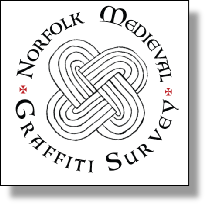








These compass drawn designs, sometimes referred to as hexfoils, are by far the most common single motif that we come across, with several thousand recorded to date. They can range from simple circles, through six petalled flower designs (known as Daisy Wheels or Hexfoils), to highly complex geometric constructions. Whilst the majority of them are small in size, being less than 100mm across, larger examples have been recorded that are nearly a metre across. It was originally believed that these designs were created by the actual masons who built the churches. They were thought to be either the mason’s teaching their apprentices the basics of geometry or creating a guide for themselves to ensure that their own dividers were correctly adjusted.
Whilst some of the compass drawn designs were undoubtedly created by the medieval masons it now appears unlikely that they were responsible for anything other than a very small percentage. The sheer number of examples, inscribed into stonework, woodwork and even the lead linings of fonts, suggest that these designs were created by far more than a single trade group and that they had a clear and distinct meaning and function. At the present time we believe that the vast majority of these designs acted as ‘ritual protection’ (apotropaic) markings. There is no simple explanation of the form and function of apotropaic markings. At their most basic level they could be seen as bringing luck and protecting individuals from evil or malign influence. At a more complex quasi-theological level they were designed to trap the demons that roamed the world within their complex structure, quite literally pinning them to the walls.
















